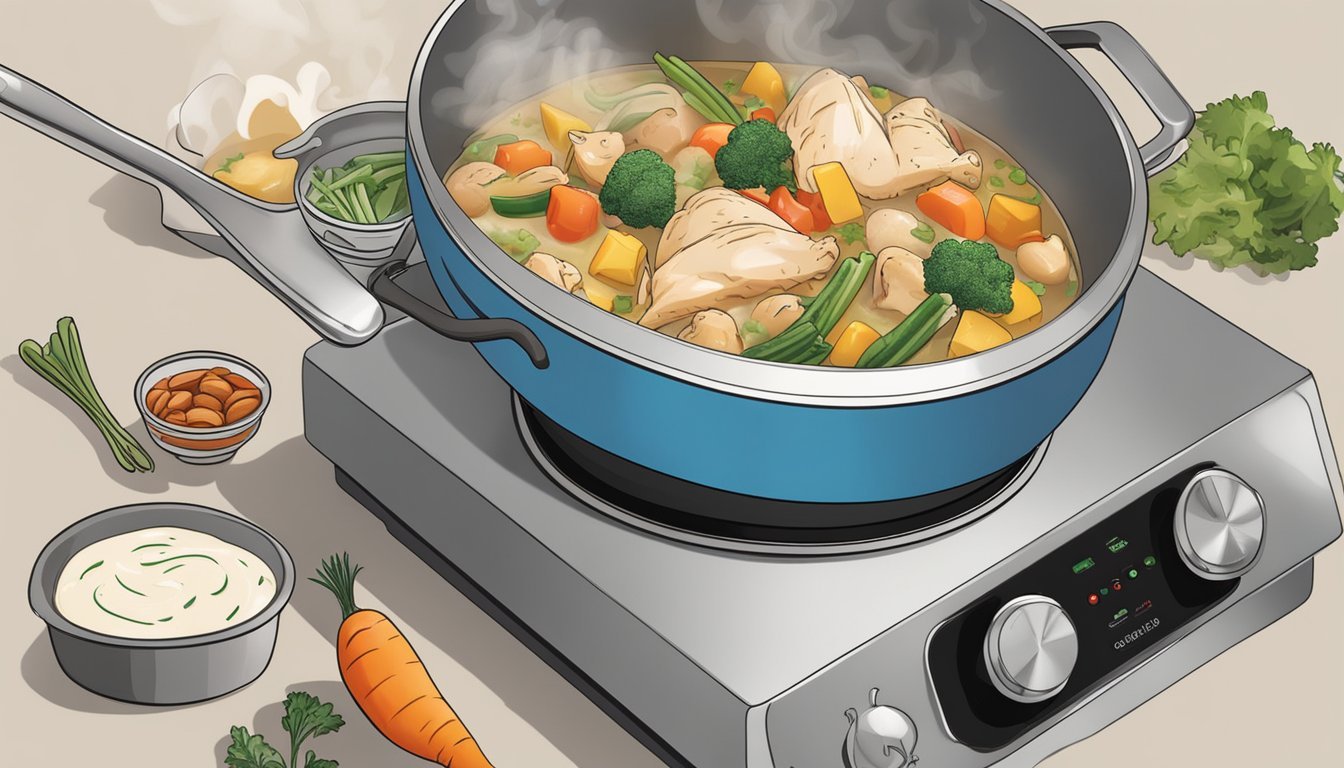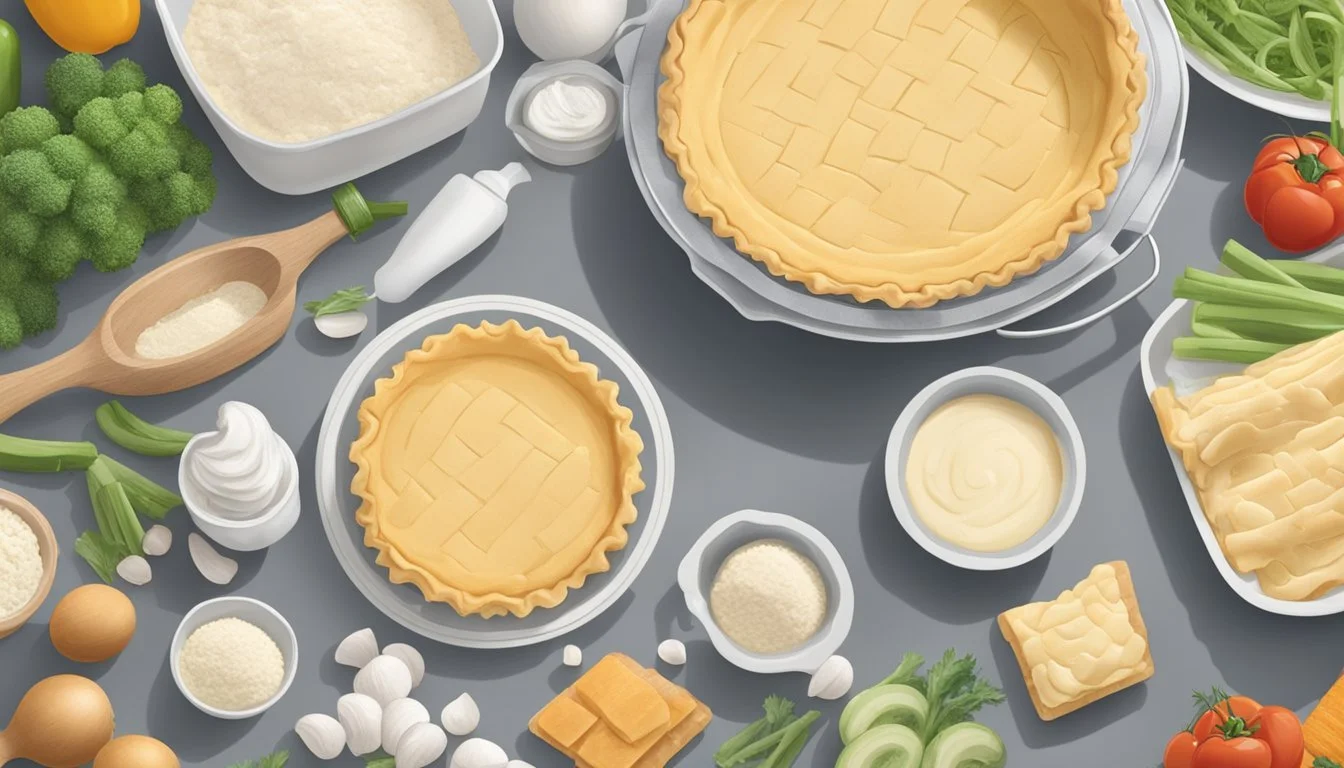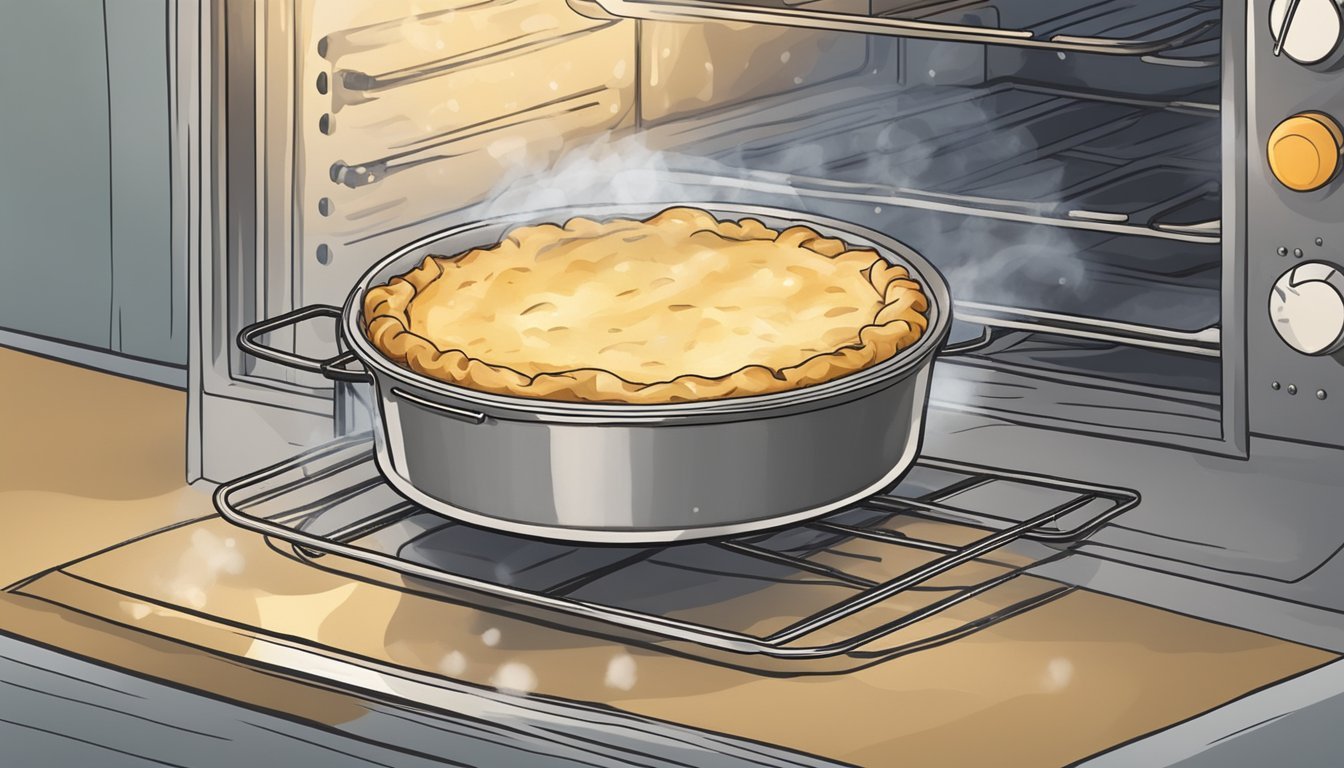How to Reheat Gluten-Free Chicken Pot Pie
Easy Steps for Perfect Results
Gluten-free chicken pot pie is a beloved comfort food for many, providing a hearty and satisfying meal that’s perfect for any season. Whether you’ve prepared your own from a trusted recipe or purchased a pre-made pie, knowing how to reheat it properly is essential to maintain its delicious texture and flavor. To ensure the best results, reheat your gluten-free chicken pot pie in the oven at 350°F until the filling is warm and the crust is crispy.
This method helps preserve the flaky crust and rich filling, avoiding a soggy result that might come from using a microwave. For those with busy schedules, a quick option is to reheat individual slices in an air fryer for a few minutes. These steps are simple yet effective for bringing your pie back to life.
Understanding the reasons behind these reheating methods can make a significant difference in your dining experience. Whether you have leftovers from a homemade recipe or a store-bought option, reusing these tips ensures your gluten-free chicken pot pie tastes as great as when it was first baked. Everyone can appreciate a warm, delicious serving of comfort food, especially when it's gluten-free and prepared with care.
Understanding Gluten-Free Ingredients
Using the right ingredients is crucial to creating a tasty, gluten-free chicken pot pie. This involves selecting suitable flour blends and choosing gluten-free vegetables and proteins.
Choosing the Right Flour Blend
A gluten-free flour blend is essential for the crust and thickening the filling. These blends often combine rice flour, potato starch, and tapioca starch, which mimic the texture of wheat flour.
Including xanthan gum or guar gum helps bind the dough together, giving it elasticity.
When selecting a blend, ensure it has a fine texture to avoid a gritty crust. Brown rice flour is often preferred for its nutty flavor while sorghum flour adds a slightly sweet taste. Consistency in your flour choice ensures predictable results each time you bake.
Selecting Gluten-Free Vegetables and Proteins
Carrots, peas, corn, and celery offer great flavor and texture. These vegetables are naturally gluten-free and provide essential nutrients.
For example, carrots add sweetness and crunch while peas provide a burst of color and sweetness. Corn is another excellent choice due to its sweetness and chewy texture.
When it comes to protein, opt for fresh, boneless, skinless chicken breasts. They cook evenly and quickly, absorbing flavors well. Make sure any processed proteins like canned chicken or pre-cooked meats are labeled gluten-free to avoid cross-contamination.
Cooking the vegetables and chicken separately ensures they are both perfectly tender and flavorful before combining them in the pot pie filling.
Preparing the Chicken Pot Pie Filling
Achieving a delectable gluten-free chicken pot pie starts with a tender chicken, flavorful vegetables, and a silky, creamy sauce. Each element must be cooked to perfection to create a cohesive and delightful filling.
Cooking Chicken to Tender Perfection
Start by selecting boneless, skinless chicken breasts or thighs for the pot pie. Season the chicken with a mixture of salt and pepper to enhance the natural flavors. Heat olive oil in a skillet over medium heat and cook the chicken thoroughly, ensuring it reaches an internal temperature of 165°F (74°C).
Once cooked, remove the chicken and let it rest for a few minutes before shredding or dicing it into bite-sized pieces. This resting period helps retain the juices, resulting in tender and moist chicken perfect for the pie filling.
Sautéing Vegetables for Maximum Flavor
Begin with the aromatics: finely chop onion and garlic. Sauté these in butter or olive oil over medium heat until they become fragrant and translucent. Add the key vegetables such as carrots, celery, and peas, cooking until they are slightly tender.
Sprinkle with a bit of salt and pepper to taste. The goal is to soften the veggies without overcooking them, as they will continue to cook in the oven. This sautéing step maximizes the flavor and ensures the vegetables are well-incorporated into the filling.
Creating the Creamy Sauce
For the creamy sauce, start by making a roux. Melt butter in a saucepan and gradually whisk in gluten-free all-purpose flour until smooth. Slowly add chicken broth, continuing to stir until the mixture thickens.
Incorporate coconut milk or dairy-free cream for a luscious texture. Season with salt and pepper to taste. Combine the sauce with the prepared chicken and sautéed vegetables, stirring gently to ensure everything is evenly coated with the rich, creamy sauce.
Transfer the filling into the pie crust, ensuring even distribution, and prepare it for baking.
Crafting the Gluten-Free Pie Crust
Creating a gluten-free pie crust involves selecting the right ingredients and techniques. It is essential to blend the dough correctly and shape it precisely for a tender and flaky result.
Mixing Ingredients for the Dough
To start, gather ingredients such as gluten-free all-purpose flour, butter, egg, and a bit of salt. The key is to use a gluten-free all-purpose flour blend that includes xanthan gum or guar gum to mimic the texture of gluten.
Cut the butter into small cubes and chill it. In a large mixing bowl, combine the flour and salt. Add the chilled butter and use a pastry cutter or your fingers to mix until the mixture resembles coarse crumbs.
Incorporate the egg to add richness and binding properties. Gradually add cold water, one tablespoon at a time, until the dough starts to hold together. Form the mixture into a ball, wrap it in plastic wrap, and refrigerate for at least 20 minutes.
Rolling and Shaping the Crust
After chilling, place the dough on a lightly floured piece of parchment paper. Flatten it slightly with your hands. Place another piece of parchment paper on top and roll out the dough to about 1/8-inch thickness, maintaining even pressure.
To transfer the rolled dough, remove the top parchment paper and lift the bottom sheet with the dough. Carefully flip it over onto your pie dish and gently press it into place. Trim any overhanging dough with a sharp knife or kitchen scissors.
For a top crust, roll another piece of dough similarly, cut a few slits for ventilation, and place it over the filling. Crimp the edges together to seal. With this method, achieving a well-textured, delicious gluten-free pie crust becomes straightforward.
Assembling the Chicken Pot Pie
To create a delicious gluten-free chicken pot pie, one must give close attention to layering the filling and crust, and applying an egg wash for a perfect golden finish. These steps ensure a flavorful and visually appealing dish.
Layering Filling and Crust
First, preheat the oven to the recommended temperature, typically around 375°F. Prepare the pie pan by lightly greasing it or lining it with parchment paper.
Begin with a well-prepared pie crust. Roll out the gluten-free dough on a lightly floured surface or between parchment paper to prevent sticking. Line the pie pan with the crust, pressing it gently to the sides and bottom.
Next, fill the crust with the prepared chicken pot pie filling. Ensure the filling is evenly distributed, allowing for consistent flavor and texture in every bite. The filling usually consists of cooked chicken, vegetables, and a savory sauce thickened with gluten-free flour.
Cover the filling with another layer of rolled-out dough. Trim any excess crust and crimp the edges to seal. This step helps keep the filling inside during baking and creates a beautifully finished edge.
Applying Egg Wash for Golden Finish
An egg wash is essential for achieving a golden, shiny crust. In a small bowl, whisk together one egg and a tablespoon of water until well combined.
Using a pastry brush, apply a thin, even coat of egg wash to the top crust, ensuring the entire surface is covered. This coating creates an appetizing golden color and adds a subtle sheen to the finished pie.
To allow steam to escape, cut small slits in the top crust. These vents prevent the pie from becoming soggy underneath the crust and help maintain a flaky texture.
Place the assembled pie in the preheated oven and bake for the time specified in the recipe. Keep an eye on the crust to avoid over-browning, tenting with aluminum foil if necessary.
Baking and Reheating Techniques
To enjoy a perfectly baked and reheated gluten-free chicken pot pie, it's essential to follow specific techniques that preserve its flavor and texture. Here's how to achieve the best results from baking to reheating.
Baking the Pie to Perfection
First, preheat the oven to 375°F (190°C). This temperature ensures an even bake without burning the crust.
Prepare your gluten-free chicken pot pie by placing it in a baking dish. If you're making the pie from scratch, ensure all ingredients are well-mixed and the crust is evenly rolled.
Cover the edges of the pie with aluminum foil. This prevents the crust from browning too quickly. Bake for 45-50 minutes or until the filling bubbles and the crust turns golden brown. If desired, brush the crust with melted butter or egg wash for extra crispiness.
Allow the pie to cool slightly before serving. This sets the filling and makes slicing easier.
Proper Reheating for Enjoyable Leftovers
For reheating leftovers, begin by preheating your oven to 325°F (160°C). Place the leftover chicken pot pie or slice in an oven-safe dish. Cover the pastry loosely with foil to prevent over-browning and drying out.
If reheating a whole pie, heat for 20-25 minutes. For individual slices, heat between 10-15 minutes. Check the pie to ensure the filling is hot and the crust remains crisp.
Alternatively, use a microwave for quicker reheating. Place a slice on a microwave-safe plate and heat on medium power for 2-3 minutes, checking periodically. This method may soften the crust, so for a crisper finish, you could use the oven after microwaving.
By following these steps, you ensure that your gluten-free chicken pot pie remains delicious and satisfying even as leftovers.
Special Diet Considerations
When reheating gluten-free chicken pot pie, certain dietary restrictions such as dairy-free and vegan preferences can be important. Below are guidelines for adapting the recipe to meet these needs.
Adapting the Recipe for Dairy-Free Options
To make a gluten-free chicken pot pie suitable for a dairy-free diet, consider replacing traditional ingredients with dairy-free alternatives. Butter can be swapped with dairy-free margarine or vegan butter. Instead of cow's milk, use almond milk, soy milk, or coconut milk.
For the gravy or sauce, use a vegetable broth or chicken broth that is free from dairy. This ensures that the dish remains creamy without compromising on taste. Many grocery stores offer dairy-free shredded cheese options that melt well if the recipe calls for a cheese topping.
Incorporating Vegan Substitutes
For a vegan-friendly version, start by substituting the chicken with tofu, tempeh, or a variety of vegetables like mushrooms, which provide a meaty texture. Instead of chicken broth, use vegetable broth to maintain flavor without animal products.
Replace eggs in the pie crust with a flaxseed meal and water mixture or applesauce, which act as binders. Vegan butter can be used in place of regular butter. These substitutions ensure that the pie maintains a rich and hearty taste without compromising on a vegan diet.
By carefully selecting ingredients, both dairy-free and vegan versions of gluten-free chicken pot pie can be delicious and satisfying.
Storage and Freezing Tips
To ensure your gluten-free chicken pot pie stays fresh, proper storage is key.
Refrigerator: Place any leftovers in an airtight container. Refrigerate within two hours of cooking.
Duration: Consume within 3-4 days for the best taste and safety.
Freezing:
Preparation: Allow the pot pie to cool completely. Wrap it tightly in plastic wrap, then a layer of aluminum foil.
Containers: Alternatively, store in a freezer-safe airtight container. Label with date and contents.
Wrap: Follow the same wrapping method as for cooked pies.
Cook Time: When ready to bake, do not thaw. Bake straight from the freezer, adding an extra 15-20 minutes to the cook time.
Defrosting and Reheating:
Defrosting: For best results, defrost in the refrigerator overnight.
Oven Reheating: Preheat oven to 375°F (190°C). Place the pie on a baking sheet. Heat for 25-30 minutes if defrosted, 45-50 minutes if frozen.
Crispy Crust Tip: For a crispier crust, brush with melted butter or egg wash before reheating.
Meal Planning:
Batch Cooking: Prepare multiple chicken pot pies at once and freeze. This approach suits busy schedules and large families.
Portion Control: Consider freezing individual servings for ease of reheating and portion control.
These tips ensure your chicken pot pie maintains its flavor and texture, whether you're saving a slice for later or prepping meals for future enjoyment.
Nutritional Information and Health Benefits
A gluten-free chicken pot pie offers a balanced meal with several vital nutrients.
Macronutrients
Calories: Typically, a serving contains about 300-400 calories, depending on the recipe.
Protein: Chicken provides a rich source of protein, often around 20 grams per serving.
Carbohydrates: Expect 30-40 grams of carbohydrates, primarily from the filling and crust substitutes.
Saturated Fat: Usually contains 5-8 grams due to the butter or dairy alternatives used.
Micronutrients
Iron: Chicken and vegetables contribute to iron intake, approximately 1-2 mg per serving.
Vitamin A: Carrots and other veggies offer a good dose of Vitamin A.
Vitamin C: Vegetables such as peas and carrots add Vitamin C, boosting immune health.
Calcium: Dairy or dairy substitutes in the recipe can supply calcium, essential for bone health.
Additional Nutrients
Fiber: Vegetables and gluten-free flours in the recipe add dietary fiber, aiding digestion.
Potassium: Potatoes or other starchy vegetables included can increase potassium intake.
Cholesterol: With ingredients like chicken and eggs, the dish should be monitored for dietary cholesterol levels, generally around 50-70 mg per serving.
Sodium: Sodium content can vary, especially with broth or seasoning, typically around 600-800 mg per serving.
Health Benefits
This dish promotes muscle maintenance due to its high protein content. Vitamins such as A and C support vision and immune function. Iron and calcium contribute to overall wellness, making gluten-free chicken pot pie a wholesome and nutritious choice.
Presentation and Serving Suggestions
For a visually appealing presentation, serve the gluten-free chicken pot pie on individual plates or small serving trays. This not only enhances the cozy feel but also makes it easier to serve.
Garnish the top of the pot pie with fresh herbs like thyme or parsley. The bright green color contrasts beautifully with the golden crust.
Add a small side salad with mixed greens and a light vinaigrette for a pop of color and a refreshing balance to the rich pie.
If serving for a larger group, consider using mini pot pies. They are both charming and practical, making snapping an Instagram-worthy picture a breeze.
For an elegant touch, use white or neutral-colored dishes. This allows the rustic look of the pot pie to stand out.
To keep the pot pie warm during a gathering, place it on a warming tray. This ensures each serving is hot and delicious.
Offer gluten-free rolls or breadsticks on the side. This can complement the meal and provide a complete dining experience.
Lastly, remember to keep napkins or small hand towels handy, as the hearty filling may sometimes spill out during serving.









